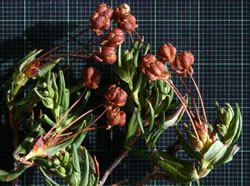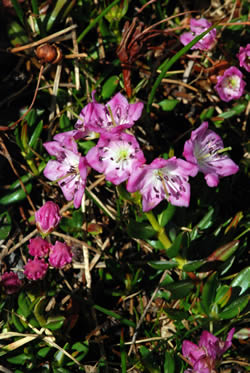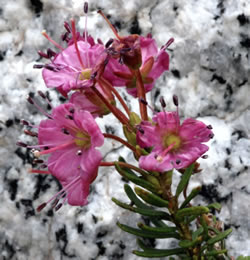Plant of the Week
 Kalmia microphylla range map. USDA PLANTS Database.
Kalmia microphylla range map. USDA PLANTS Database.
 Kalmia microphylla, Mount Adams, Washington. Photo by Susan McDougall.
Kalmia microphylla, Mount Adams, Washington. Photo by Susan McDougall.
 Closeup of the woody capsules (fruit) of Kalmia microphylla, Maybird Lakes, Salt Lake County, Utah. Photo by Bill Gray.
Closeup of the woody capsules (fruit) of Kalmia microphylla, Maybird Lakes, Salt Lake County, Utah. Photo by Bill Gray.
 A colorful colony of Kalmia microphylla in a mountain meadow. Photo by Charles Webber © California Academy of Sciences.
A colorful colony of Kalmia microphylla in a mountain meadow. Photo by Charles Webber © California Academy of Sciences.
 Kalmia microphylla, Conness Lakes, California. Photo by Barry Brecking.
Kalmia microphylla, Conness Lakes, California. Photo by Barry Brecking.
Bog Laurel (Kalmia microphylla)
By Walter Fertig
Carl Linnaeus, the godfather of plant taxonomy and the inventor of the Latin binomial system used to name plants and animals since the mid 1700s, is less well known for his role in encouraging exploration of the far corners of the globe for new species. Linnaeus himself traveled relatively little, but he sent out a number of his students and colleagues to collect specimens that he would later catalogue. One of his more successful students was a Finnish orphan reared in Sweden named Pehr Kalm (or anglicized as Peter Kalm). Kalm was sent to North America in 1748 with instructions to collect plants of economic value (especially Red mulberry to help start a Finnish silkworm industry) and new species for Linnaeus. Kalm collected nearly 100 plant species for his mentor, of which 60 were described as new to science. One of the new species was Mountain laurel (Kalmia latifolia), which Linnaeus named for his pupil. Kalm went on to later fame as a writer (his chronicle of early colonial life in America is still widely used by historians) and was the first scientist to describe Niagara Falls.
The genus Kalmia contains 7-10 species (depending on whether related genera Loiseleuria and Leiophyllum are included), all native to North America. Many are called laurels due to the resemblance of their leathery, entire leaves with inrolled margins to those of Sweet bay or the Laurel of antiquity (Laurus nobilis). The resemblance is only superficial, as Kalmia is a member of the heath family (Ericaceae), while Laurus is in its own family (Lauraceae) and more closely related to magnolias.
Kalmias are easily recognized by their unusual flowers. Like many heaths, the petals are fused into a shallow, 5-lobed bowl. The surface of the bowl is interrupted by ten pocket-like indentations. As the flower bud matures, the expanding stamens thrust their pollen-bearing anther heads into these pockets. When the flower is fully open, the anthers are held under spring-like tension until a large-bodied insect (like a bumblebee) triggers the stamen and is showered by pollen. The bee will carry this pollen lode to the next Kalmia flower it visits (perhaps being showered yet again) and deposit some on the stigma to bring about cross-pollination. Inquisitive humans can also spring the stamens.
Bog laurel (K. microphylla) is a low shrub mostly less than 8 inches tall with opposite leaves and deep pink flowers arranged in a small umbel at the tips of larger stems. As its common name suggests, it is frequent in boggy habitats, but can also occur along lakeshores, streams, and wet mountain meadows. Bog laurel ranges from Alaska to Ontario and south to California, Utah, and Colorado. In the northeast, it is replaced by the morphologically similar Kalmia polifolia, which tends to be more robust, have more slender leaves, and double the number of chromosomes. Larger relatives of the bog laurels, such as Mountain laurel and Sheep laurel (K. angustifolia) are often cultivated for their showy flowers and handsome foliage. All of the Kalmia species are suspected of being poisonous to livestock and humans, though they are rarely ingested.


